《1 Introduction 》
1 Introduction
For a long time, the demand for coal in China’s economic and social development has maintained a growth trend, and the coal industry has developed rapidly. In 2020, China’s total primary energy production was 4.08×109 tce, the output of raw coal was as high as 3.9×109 t, the year-on-year growth rate was 1.3%, total energy consumption was 4.98×109 tce, and the proportion of coal consumption was 56.8% [1]. At present, China has entered a new stage of high-quality development, focusing on forming green production and a green lifestyle, and striving to achieve a carbon peak in 2030 and carbon neutralization in 2060. Major changes have taken place in the main problems faced by the coal industry, from “expanding capacity and ensuring supply to meet residents’ coal needs” in the past to “developing and utilizing coal with high quality to meet residents’ needs for a better life” in the new situation. Unbalanced and insufficient development of the coal industry is becoming increasingly prominent [2], and the extensive development model can no longer meet the requirements of the new era [3–7]. Therefore, the coal industry needs to accelerate the transformation of the development and utilization modes and study the specific path toward high-quality development in depth.
Domestic industry institutions, experts, and scholars have actively researched the high-quality development of the coal industry. For example, through technological innovation and optimal allocation of factors, we can meet the needs of economic and social development for coal at a lower social cost [8]. Coal mine intellectualization is the core technical support for high-quality development of the coal industry and represents the development direction of advanced coal productivity [9]. Its main features include safe, green, efficient, sustainable, open, and shared [10]. Overall, in view of this new proposition, it is still necessary to analyze the development connotation, element characteristics, and strategic path to establish a theoretical basis comprehensively, deeply, and systematically for scientifically planning the medium- and long-term development of the coal industry.
Based on an in-depth analysis of the problems faced by the development of the coal industry, this study attempts to accurately define the connotation of high-quality development of the coal industry. It establishes and uses relevant evaluation index systems and methods, proposes development objectives and key tasks, and offers countermeasures and suggestions to provide a basic reference for high-quality development of the coal industry.
《2 Analysis of the problems of coal industry 》
2 Analysis of the problems of coal industry
《2.1 Imbalance of industry development》
2.1 Imbalance of industry development
2.1.1 The mining efficiency and technical level of mines are unbalanced
The production efficiency of China’s coal enterprises varied significantly. The average production efficiency of state-owned coal enterprises dominated by large coal mines is approximately 2800 t/(work·years), and the annual per capita efficiency of the eastern open-pit mine of ChinaCoal Pingshuo Group Co., Ltd. is 68 000 t/(work·years) at the international leading level. The production efficiency of small coal mines is usually only 300–500 t/(work·years). The overall production efficiency of China’s coal industry is significantly different from that of developed countries in the world; for example, approximately 12 000 t/(work·year) in the United States and approximately 9000 t/(work·year) in Australia [11]. The imbalance in coal mine production technology in China is the main factor.
In recent years, China’s coal industry has accelerated the development of information and intelligence. By 2020, 494 intelligent coal mining faces had been built, realizing “one key start on the ground, patrol, and unattended underground” [12]. Although significant progress has been made in the intellectualization of large mines, the vast majority of mines still maintain their original state, and some backward mines have a low degree of mechanization and automation (using backward mining technologies such as blasting mining and blasting excavation). The coexistence of blasting mining and intelligent coal mining seriously restricts the overall high-quality development of the coal industry.
2.1.2 Unbalanced market structure
China’s coal industry has a low market concentration and a large number of small enterprises. Low market concentration easily causes excessive competition. Moreover, unregulated competition is prominent, which is not conducive to the efficient and sustainable development of the entire coal industry. The dynamic change mechanism was weak. To improve the safe production and technical level of the coal industry, we should shift toward largescale and intensive operations, and the restructuring of the coal industry should be accelerated. For example, in 2020, the raw coal output of China’s top eight large enterprises was 1.855 × 109 t (accounting for approximately 47.6% of the country; see Fig. 1), which is significantly lower than that of large coal-producing countries such as the United States, Russia, and India (where the output of the top eight coal enterprises accounts for 55%–65% of the country and the characteristics of a monopoly industrial structure are obvious).
《Fig. 1》

Fig. 1. Raw coal production of China’s top 8 coal enterprises (2011–2020).
2.1.3 The degrees of cleanliness and quality of coal utilization are unbalanced
China’s coal consumption is mainly distributed in electric power, iron and steel, building materials, chemical industries, and other industries. There is also a certain proportion of decentralized coal consumption, and the clean utilization levels of the various modes are different. In 2019, over 80% of coal power achieved ultralow emissions, and was green and efficiently utilized. Ultralow emissions from coal for iron and steel are promoted, and the level of pollutant emission control is further improved. Advanced industrial boilers have been popularized and applied in the building materials industry, with a combustion efficiency of more than 80% and pollutant emissions in line with national standards. However, the application proportion still needs to be improved. Bulk coal is usually inferior with high ash and sulfur contents. There is often a lack of desulfurization, denitration, and dust removal treatments during combustion, resulting in serious pollution due to direct combustion and discharge. Decentralized coal is being replaced by “double generation” or high-quality coal + high-efficiency stoves, the total amount continues to decrease, and pollution emissions are being reduced by approximately 70% (compared with 2015); however, decentralized coal is still the main nonpoint source of coal consumption pollution in China.
《2.2 Inadequate development of the industry 》
2.2 Inadequate development of the industry
2.2.1 Inadequate safety development
After the implementation of measures such as comprehensive safety management and correction of excess capacity in the coal industry, backward production capacity has been phased out, and major production accidents have been significantly reduced. The mortality rate per million tons of coal in China decreased to 0.059 in 2020 (Fig. 2), thereby realizing a fundamental improvement in the safety of coal mines [13]. It should also be noted that problems such as a poor working environment and the insufficient occupational health protection of employees in the coal industry still exist. For example, the annual mortality rate of coal employees is twice that of the construction industry, and the noise and dust pollution caused by underground operations have not been appropriately addressed. Sustained efforts are still needed to achieve the safe development of the coal industry.
《Fig. 2》
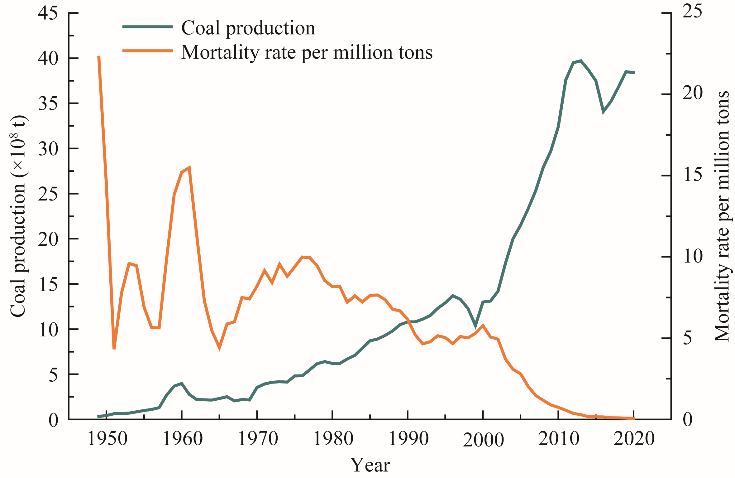
Fig. 2. Historical evolution of raw coal output and the mortality rate per million tons of coal in the coal industry.
2.2.2 Insufficient green development
China has implemented green mine construction since 2010, and some coal mining areas have been built into green mining areas, which has significantly improved the quality of the ecological environment around the mining areas. However, most coal mining areas still have serious environmental problems, such as mining subsidence, flooding or salinization of a large area of land in the eastern plain mining area, soil erosion, and desertification in the western mining area. The pollution of water resources during coal mining has increased, further exacerbating the shortage of water resources [14]. There is still a gap between the green development level of the coal industry and national requirements.
2.2.3 Insufficient low-carbon development
China’s measures to deal with climate change will be accelerated by the proposal of carbon peak and carbon neutralization goals. Coal accounts for approximately 44% of the world’s total carbon emissions and is the main source of energy responsible for carbon emissions. Controlling total coal consumption and improving the intensive low-carbon level will be the internal requirements for carbon emission reduction in the coal industry in the future. At present, China’s total coal consumption control has made positive progress, has entered the platform period, and will accelerate its peak, but the CO2 produced during coal power generation and chemical conversion processes remains difficult to dispose of. Carbon disposal technology, represented by carbon capture, utilization, and storage (CCUS), is facing technical and economic challenges, making commercialization and application difficult in the short term. The emission control level of methane produced by coal development is low (the utilization rate of underground gas drainage is only 44.8% in 2020). As a result, there is an urgent need to improve the development, utilization scale, and quality of coal mine gas and coalbed methane.
2.2.4 Inadequate human resource development
At present, there is still a large gap between the talent team in the coal industry and the internal demand for highquality development, which is mainly reflected in the large number of employees in a typical labor-intensive industry. The serious aging of personnel, shortage of a reserve labor force, poor working environment, low treatment, and relatively closed traffic in coal mines make it difficult to recruit workers to the front-line underground. There is a shortage of senior technicians, making it impossible to meet the information and intelligent mine construction needs in the future. Simultaneously, the supply of mining engineering students in colleges and universities is becoming increasingly tight, the rate of high-level brain drain from scientific research institutes is high, and the contradiction between the supply and demand of coal human resources is becoming increasingly obvious.
2.2.5 Insufficient foreign cooperation
Foreign cooperation in the coal industry is mostly about “bringing in” and less about “going out.” Most foreign enterprises participate in domestic market competition, whereas domestic enterprises participate less in international market competition. Most foreign enterprises are involved in the coal trade, and there is little international cooperation in technology, talent, market, and capital. There are few successful cases of overseas investment by domestic enterprises; the risk of transnational investment is still high, and the ability to make overall use of international and domestic markets and resources is still weak. Comprehensively improving the quality of China’s coal industry’s international cooperation and internationalization level has become an important topic that must be dealt with scientifically and efficiently.
2.2.6 Insufficient enterprise transformation and upgrading
Recently, coal enterprises have sought diverse development paths. Through integrated development with downstream industries, new technologies, and new business forms, some large coal enterprises have initially formed a coordinated development pattern based on the coal, coal power, and coal chemical industries, in addition to the coal steel, building materials, finance, and new energy industries as well as other related industries, and at the same time, they have actively explored overseas markets. However, most coal enterprises still have a single business model of “mining and selling coal,” which focuses on coal exports and does not extend much to high-end industries. As a result, the profitability of enterprises depends more on coal prices and does not form the resource advantage or risk prevention ability of sustainable development.
《3 Connotation of the high-quality development of the coal industry》
3 Connotation of the high-quality development of the coal industry
Facing the new situation of green energy development and the new requirements for coping with climate change, combined with the characteristics of the coal industry and the high-quality development experience in other energy fields, this study defines the connotation of the high-quality development of the coal industry as follows: the industry should take safe green intelligent mining and green low-carbon efficient utilization as the main direction. New energy and technologies in the coal industry should be promoted. Thus, new industries should be deeply integrated. New business forms and models should be continuously developed and applied. Moreover, changes in power, quality, and efficiency in the coal industry should be promoted. Thus, the transformation of coal from high-carbon to green energy should be promoted. High-quality development of the entire process and the elements of coal development and utilization should be realized. Specifically, the high-quality development of the coal industry should have the basic characteristics of “three highs and three lows.”
High efficiency refers to the full use of advanced technology in all links of coal production, transportation, and consumption to become economical and efficient. The proportion of advanced production capacity greatly increases and the work efficiency of all staff significantly improves. Additionally, the comprehensive coal logistics channel and the modern coal logistics system are perfect. The utilization of coal is concentrated on large users, such as users for power generation and transformation, greatly improving the efficiency of coal-fired power generation and chemical transformation and achieving a significant reduction in coal consumption.
High safety refers to the step from “low deaths” to “zero deaths” and then to “zero casualties,” and it comprehensively improves the intelligence level of coal mine development, mining (stripping), transportation, ventilation, washing, safety guarantee, operation, and management [15].
High-level talent refers to gathering and training a high-quality talent team to meet the development needs of the industry at the new stage and to support and lead the progress of the industry. It includes a group of scientists engaged in basic research, various engineering and technical professionals engaged in research on core technology, key technology, and common technology, and operation and management professionals who are familiar with international market rules and who have rich engineering experience.
Low damage means that coal mines fully realize green mining; minimize the impact of coal mining on the ecological environment; minimize pollution and damage to air, land, and water resources; and restore the ecology in a timely manner and with high quality.
Low emissions refer to the efficient utilization of coalbed methane resources associated with coal development (reducing gas emissions), full resource reuse of bulk solid waste, ultralow emissions from coal combustion, clean transformation of coal, full cycle of and zero emissions from wastewater (significantly reducing the carbon loss rate), and research on carbon disposal technology for coal development and utilization to achieve carbon emission reduction.
Low injuries refer to the minimization of personal injuries to employees. This includes improving the harsh working conditions of high temperature, vibration, and high humidity underground; strengthening occupational health education and training for miners; providing health examinations, occupational disease diagnosis and treatment, and other prevention services; actively intervening in the prevention and control of the mental health of underground workers; and realizing zero new cases of occupational diseases.
《4 Evaluation of the high-quality development of the coal industry 》
4 Evaluation of the high-quality development of the coal industry
《4.1 Evaluation index system》
4.1 Evaluation index system
Guided by the connotation of the high-quality development of the coal industry, a three-level evaluation index system is constructed based on three aspects, that is, power change, quality change, and efficiency change, covering five dimensions: innovation-driven, intelligence and high efficiency, diversification and the economy, safety and health, and green and low carbon, as well as 23 specific indicators (Table 1).
《Table 1》
Table 1. Evaluation index system for the high-quality development of the coal industry.
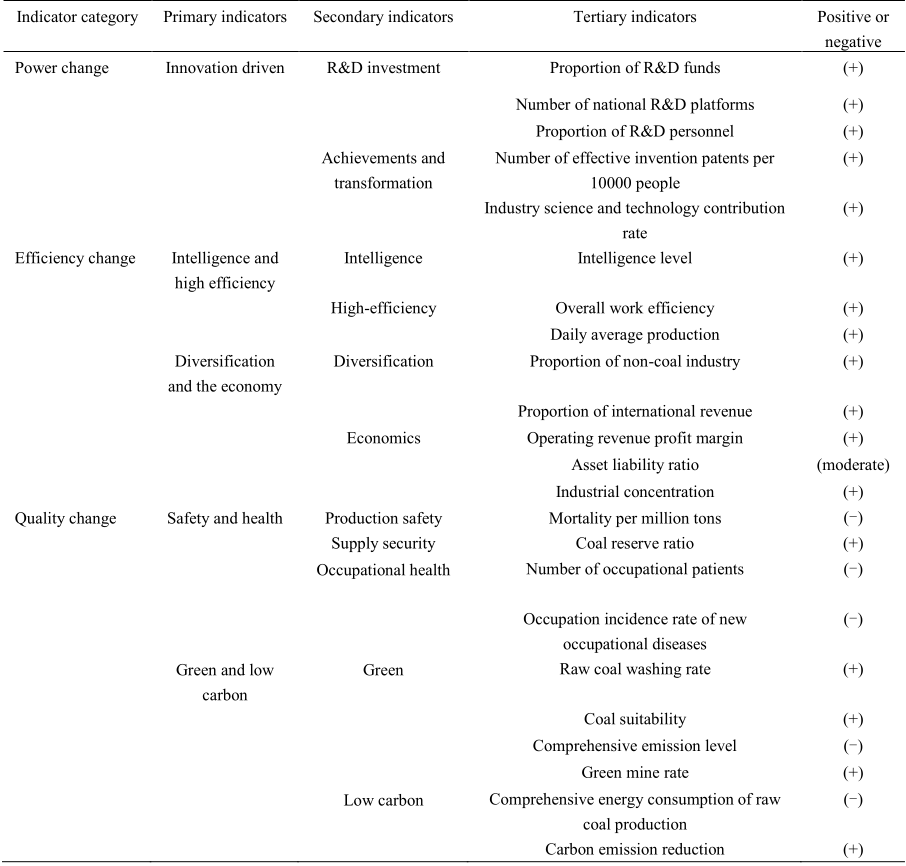
《4.2 Evaluation model》
4.2 Evaluation model
Before a comprehensive evaluation, the weight of each index should first be determined. The advantage of the objective weighting method is that it is not affected by human factors and is determined only by the nature of data distribution. The results obtained by relying only on objective data sometimes deviate from the actual situation, whereas a subjective weight inevitably depends on expert scoring and is affected by human factors. An index weight determined by the single weighting method is biased, and it is difficult to comprehensively consider all factors. Therefore, this study first uses the entropy weight method to calculate the objective weight of each index and then introduces the subjective weight method to correct the relevant weights using expert judgments. On this basis, a combined weighting process was formed. That is, an optimization model aiming at the minimum deviation from the known subjective and objective weights is established, and the optimized comprehensive weight is determined by solving the model.
There are many comprehensive evaluation methods for multiple indicators, and gray correlation analysis is one of them. It combines qualitative and quantitative analyses, making it suitable for problems in which the evaluation indicators are difficult to quantify and count. However, the corresponding comprehensive evaluation has the disadvantage of “relative evaluation,” and the calculated correlation degree is always positive. Therefore, this study used the TOPSIS method to modify the grey correlation analysis and construct the GRA-TOPSIS comprehensive evaluation method. The corresponding calculation process is illustrated in Fig. 3. The ranking is carried out based on the distance between the evaluated object and the optimal and worst solutions, which compensates for the fact that the grey correlation analysis considers only the positive ideal scheme and for the deficiency of using distance to describe the difference in schemes.
《Fig. 3》
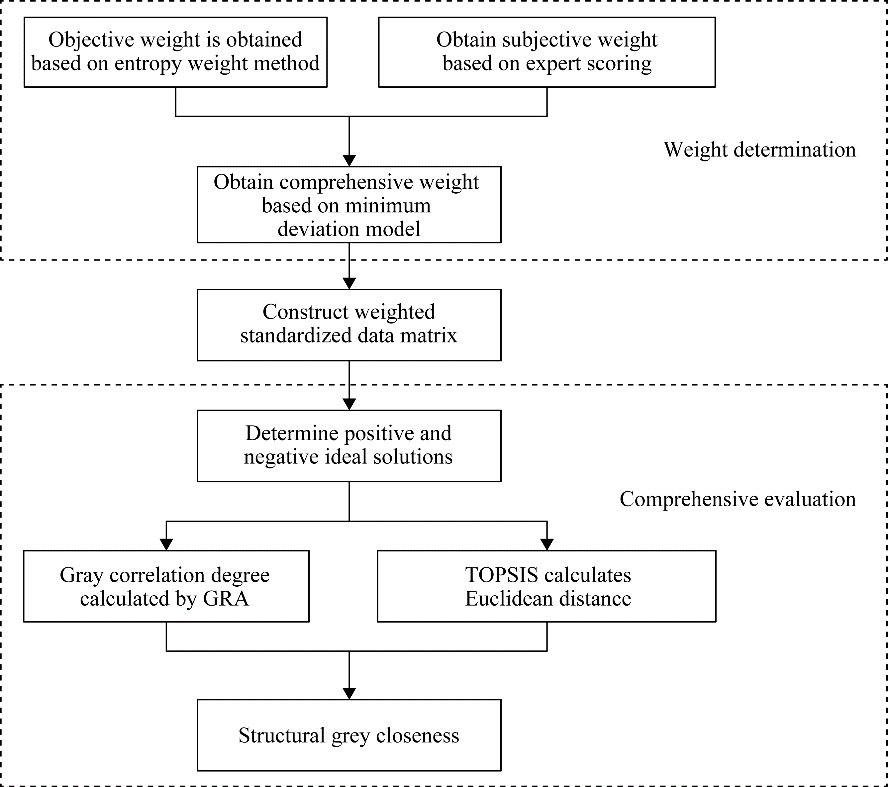
Fig. 3. GRA-TOPSIS comprehensive evaluation process.
Based on the value range of the grey closeness degree and the theory of the industrial development stage, the high-quality development of the coal industry is divided into five levels: high ([0.9,1]), relatively high ([0.8,0.9)), medium ([0.6,0.8)), relatively low ([0.4,0.6)), and low ([0,0.4)).
《4.3 Evaluation application》
4.3 Evaluation application
Coal industry data from 2011 to 2019 were selected for high-quality development evaluation, and the relevant data were obtained from the National Bureau of Statistics, statistical yearbooks, and the Wind database. Using the GRA-TOPSIS comprehensive evaluation model, the standardized data were substituted into the model for calculation, and the evaluation results of the development level of the coal industry were obtained (Figs. 4 and 5). From 2011 to 2019, the overall development level of the coal industry was 0.4–0.7 and steadily increased annually. The industry development score in 2019 was 0.6776, which is in the initial stage of the medium and upper levels, and there is still a large gap from the high-level stage.
《Fig. 4》
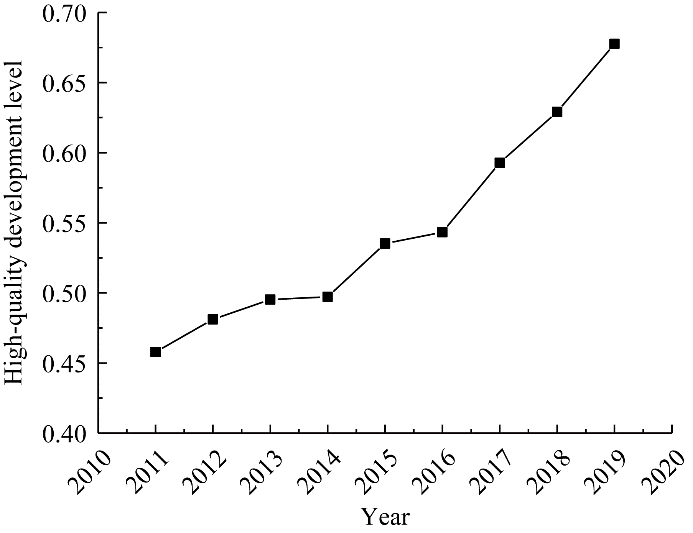
Fig. 4. High-quality development level of the coal industry.
《Fig. 5》
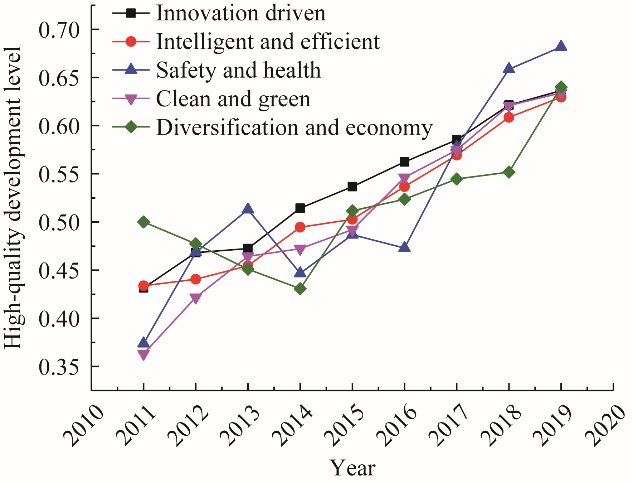
Fig. 5. Development level of the high-quality subsystem in the coal industry.
Regarding the five subsystems, innovation-driven, intelligence and high efficiency, safety and health, green and low carbon, and other indicators show a fluctuating upward trend. Among them, the green and low-carbon indicator changes the fastest, which shows that in recent years, the coal industry has taken effective measures in green mining and pollutant emission control, and the level of cleanliness and greening has significantly improved. An intelligent, efficient, and diversified economy remains a springboard for the development of the coal industry. In the next stage, we should “make up for weaknesses and exploit strengths,” quickly improve the development level of the specific direction of the coal industry, and improve the development quality level of the whole industry.
《5 Key tasks for the high-quality development of the coal industry》
5 Key tasks for the high-quality development of the coal industry
The high-quality development of the coal industry will not be achieved overnight. Instead, it must rely on the existing foundation and conditions step by step, and a two-step strategy—stage breakthrough and major breakthrough—can be implemented. In the stage breakthrough period, it is important to expand the application of safe, green, and intelligent mining technology, further improve the green and low-carbon level of the whole process of coal utilization, and gain time for the transformation to high-end and low-carbon industries. During the major breakthrough period, intelligent mining will be fully applied throughout the country, and coal will become a green energy with zero environmental damage and zero climate load through technological change.
《5.1 Building an innovation-driven green intelligent development system》
5.1 Building an innovation-driven green intelligent development system
It is critical to establish a green development concept for the entire lifecycle of coal. The concepts of advanced environmental protection, green exploration, near-zero-damage green mining, energy-saving, and low-carbon green utilization should be established to minimize the damage caused by coal production to the ecological environment and to make efficient and full use of coal resources. A comprehensive technical standards system for green exploration and green mine construction should be developed, as well as the popularization and application of new technologies, processes, and materials. Likewise, it is important to build a green development and treatment technology system [16], realize green mining, build ecological mines, and maintain the long-term development of green coal.
Considering intelligent coal mine construction as the overall guide of industrial development, it is important to tackle the key core technologies of intelligent coal mines and create a new model of green, safe, intelligent, and efficient coal mine development. The supporting measures of smart coal mines and the technical standards, operation management specifications, and safety regulation systems of smart coal mines and intelligent mining should be improved. Integrated solutions, system maintenance cloud services, and professional market-oriented team services should be promoted [17].
《5.2 Building a coordinated and integrated green and low-carbon development system》
5.2 Building a coordinated and integrated green and low-carbon development system
It is essential to improve the green level of the entire process of coal utilization; standardize the standards of cleaner production, pollutant emissions, and product quality in the coal quality improvement and processing industry; classify and refine the cleaner production guidance directory of small- and medium-sized coal processing enterprises; and realize accurate management by category [18]. An advanced technological system for the clean utilization of coal should be developed. The energy-saving level of production in the coal industry and the systems of energysaving supervision, reviews, and supporting facilities should be improved.
It is also important to improve the economy of CCUS applications through technological progress and to continuously reduce the total carbon emissions from electricity, chemistry, governance, construction, and other major consumer ends. Furthermore, it is important to explore and establish technology, processes, and equipment systems applicable to the development and utilization of CBM in different regions, greatly improve the scale, efficiency, and quality of CBM extraction and utilization, and reduce carbon emissions [18]. An in-depth combination of coal and renewable energy production should be promoted based on the process characteristics and location of coal mine production.
《5.3 Building a coal supply system with coordinated production and demand》
5.3 Building a coal supply system with coordinated production and demand
It is vital to make full use of information technology to realize an accurate connection between coal supply and user demand, implement order production based on user demand, and improve the coal supply capacity on demand. Thus, the precise management mechanism of coal quality should be improved. Customized products with different coal specifications for technology and equipment should be provided. The docking mode between the coal supply and user sides should be optimized.
Moreover, it is important to build efficient and intelligent “flexible coal mines,” reasonably reduce the intensity of manual use, establish the ability to rapidly adjust coal output, and enhance the flexibility of coal supply and market adaptability. We will continue to optimize the industrial structure of the coal industry, develop 100 million tons of large coal backbone enterprises and enterprise groups, and consider the construction of large groups as an important measure for the reform of industrial organizations. The establishment of large-scale coal enterprise groups across regions and industries should be encouraged, and rapid changes in industry with an improvement in industrial concentration should be promoted.
《5.4 Building a comprehensive and open system of win-win cooperation》
5.4 Building a comprehensive and open system of win-win cooperation
It is pivotal to introduce advanced technical equipment and management methods to improve overall productivity in the coal industry. Furthermore, it is important to participate in the development and trade of international coal resources and to speed up the pace of globalization. The breadth and depth of international coal industry cooperation should be expanded and a diversified and networked cooperation system of investment, production, trade, and operation should be built.
Building a comprehensive and open system of win-win cooperation should be closely linked to the Belt and Road, the need for the development of the coal industry, and the promotion of international cooperation in the coal industry. It is important to rely on the existing international energy cooperation mechanism and effectively promote the establishment of stable coal partnerships with other countries or regions. We advocate safe, green development, the clean and efficient utilization of coal internationally, and strive to become leaders in the clean transformation of the global coal industry. It is important to conduct international cooperation based on local conditions and establish a differentiated and efficient cooperation model based on the differences in national markets.
《5.5 Building a high-quality talent team》
5.5 Building a high-quality talent team
The discipline and specialty settings of coal colleges and universities should be adjusted in a timely manner, and the layout of the discipline and specialty system should be optimized. It is important to accelerate the construction of emerging interdisciplinary disciplines and to set up “mining + information technology,” “mining + environmental protection” and other composite disciplines required by the coal industry at present and in the future through professional transformation. Reform of the training mode for coal-related graduate students should be promoted. The scale of graduate education in important basic research, key scientific research, and major engineering and technology fields should be expanded appropriately. Consistency between the cultivation of talent and the needs of the industry should be maintained.
It is important to build a national demonstration training base for high-skilled coal talent, to implement a training plan for high-skilled talent in the coal industry, the adjustment and revitalization plan for the coal industry, the national medium- and long-term coal science and technology development plan, and to maintain a close combination with the organization and implementation of major engineering projects to synchronize the training of high-skilled talent in the coal industry with the development of project construction.
《6 Countermeasures and suggestions》
6 Countermeasures and suggestions
《6.1 Promoting carbon emission reduction in the coal industry and realizing high-carbon energy and lowcarbon utilization》
6.1 Promoting carbon emission reduction in the coal industry and realizing high-carbon energy and lowcarbon utilization
Therefore, it is important to establish and improve carbon emission measurements and emission reduction systems for coal development and utilization. Carbon emission measurement methods and databases should be developed for the entire process of coal development and utilization, the carbon emission base and individual differences should be determined, carbon emission standards should be formulated for relevant links, and coal-related enterprises should be guided to actively promote carbon emission reduction. Carbon emission reduction technology should be implemented throughout the process of coal development and utilization, and a carbon emission reduction R&D system revolving physics, chemistry, and biology should be formed. New carbon use, carbon fixation, and carbon absorption technologies, such as carbon storage in the underground space of abandoned coal mines, CO2 mineralized power generation, and CO2 chemical products and carbon absorption, which are deeply integrated with ecological and environmental protection in mining areas, will be listed as priority support directions in the national science and technology development plan. It is important to implement low-carbon emission actions, issue low-carbon emission incentives, and drive coal mines (districts) and coal-consuming enterprises to fully exploit their own advantages to significantly reduce carbon emissions.
《6.2 Improving the balance of coal production and demand and responding flexibly to sudden demand》
6.2 Improving the balance of coal production and demand and responding flexibly to sudden demand
Coal enterprises actively use information technology such as big data, artificial intelligence, and blockchain to upgrade their production management systems to meet the demand for coal order production. It is important to establish emergency response mechanisms for epidemic situations and international energy cooperation, and to establish cross-departmental and cross-regional dynamic linkage organizations. In view of the possible sudden demand, diversified coal import channels and market operation modes should be improved, and the deployment and construction of strategic reserves for clean coal transformation should be conducted regularly. Furthermore, it is critical to build “flexible coal mines” and form a demonstration effect, quickly adjust coal output, and enhance the flexibility of coal supply and market adaptability.
《6.3 Deeply combining coal with other energy sources to form a new coupling development model》
6.3 Deeply combining coal with other energy sources to form a new coupling development model
It is necessary to strengthen the deep integration of coal with oil and natural gas, support the coupling development of coal with new and renewable energy sources such as solar energy, wind energy, hydropower, and bioenergy, develop a new model of clean and efficient utilization of coal, and improve the quality of energy utilization. It is suggested that, in the national energy strategy, the coupling utilization mechanism of new energy and fossil energy such as coal, oil, and natural gas should be included, and financial, tax, and financial support methods to promote the coupling utilization of coal and new energy should be studied and formulated. It is important to actively conduct technological R&D and engineering demonstrations of coupled power generation, coupled combustion, coupled chemical transformation of coal, and new energy sources such as wind energy, solar energy, and biomass.
《6.4 Implementing coal development and utilization, saving energy and improving efficiency, and significantly reducing coal consumption》
6.4 Implementing coal development and utilization, saving energy and improving efficiency, and significantly reducing coal consumption
In the process of coal development, it is important to limit the allocation of equipment and capacity beyond the designed capacity of coal mines and to avoid the phenomenon of a “big horse pulling a small car.” We urge coal mines to use energy-saving technologies and equipment, such as frequency conversion, to reduce energy consumption in the production process. To reduce coal consumption, coal mines should make full use of waste heat resources, such as mine water and return air. It is necessary to promote coal mine gas extraction and utilization, develop methane collection and efficient utilization technologies in abandoned mines and coal mining, and reduce direct methane emptying. In coal processing and circulation, accurate and appropriate product quality classification standards should be established, the coal supply and market demand should be efficiently connected, and the adaptability of coal quality and coal-consuming equipment should be significantly improved. In terms of coal utilization, it is important to optimize the coal consumption structure and reduce inefficient and decentralized use of coal. High-efficiency coal-fired generating units with ultrahigh parameters and a wide-load coal-fired power generation system suitable for large-scale renewable energy access should be built to satisfy the requirements of high-efficiency energy consumption under complex working conditions.
《6.5 Improving the concentration of coal production and implementing the mechanism of backward production capacity and coal mine closure》
6.5 Improving the concentration of coal production and implementing the mechanism of backward production capacity and coal mine closure
Mergers and acquisitions should be encouraged to optimize the layout of coal production, eliminate backward production capacity that makes it difficult to achieve safety, efficiency, and green and maintain a reasonable increase in the concentration of coal production. It is, therefore, important to formulate management policies for the normalization of coal mine closures and exits, promote the transformation of coal mines from policy closure to market-oriented closure, and ensure the re-employment of workers to realize the smooth exit of workers. Furthermore, it is vital to establish coal mine closure assessment standards and methods, strengthen supervision and assessment, and require coal mines to clarify their future closure/exit plans during the construction stage. It is proposed, thus, that national and local special funds be established for the closure of coal mines. These funds will be used for ecological restoration and facility demolition after coal closure.

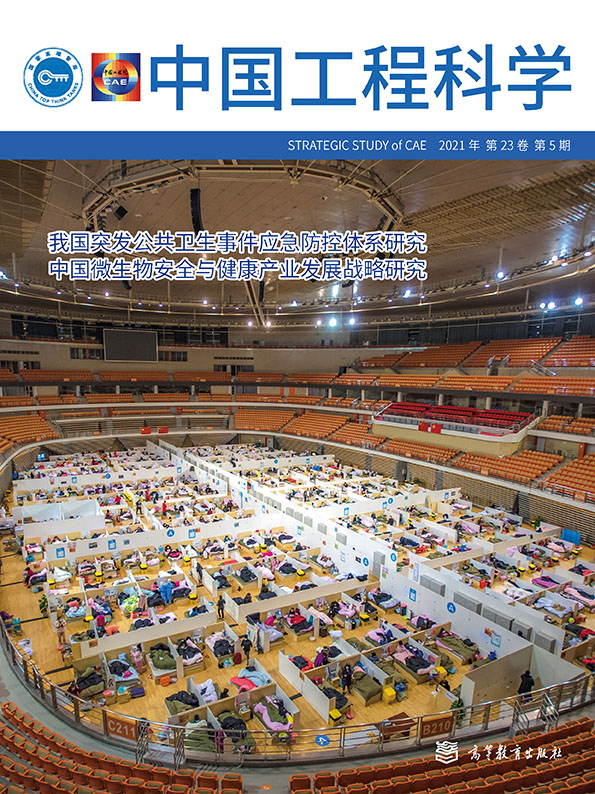












 京公网安备 11010502051620号
京公网安备 11010502051620号




